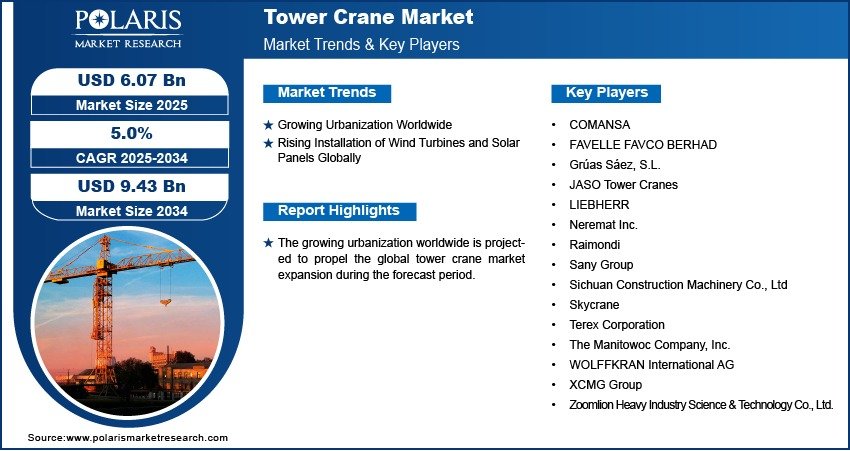Tower Crane Market Projected to Reach USD 9.43 Billion By 2034, Growing at a CAGR of 5.0%

The global Tower Crane market size was valued at USD 5.79 billion in 2024 and is projected to grow from USD 6.07 billion in 2025 to USD 9.43 billion by 2034 , exhibiting a Compound Annual Growth Rate (CAGR) of 5.0% during the forecast period from 2025 to 2034 .
- Rising Urbanization and Infrastructure Development: Rapid urbanization, especially in Asia Pacific and Latin America, is driving demand for high-rise construction projects, which in turn boosts the need for tower cranes.
- Growth in Residential and Commercial Construction: The expansion of residential complexes, office buildings, and mixed-use developments is increasing the adoption of tower cranes due to their efficiency in lifting heavy materials at height.
- Adoption of Smart and Automated Cranes: Manufacturers are introducing smart tower cranes equipped with IoT-based monitoring systems, remote control capabilities, and predictive maintenance features to improve safety and operational efficiency.
- Increasing Use in Renewable Energy Projects: Tower cranes are increasingly being used in wind energy infrastructure projects for the installation of wind turbines, offering new growth opportunities.
- Government Investments in Public Infrastructure: Many governments are investing heavily in public infrastructure such as airports, metro rail systems, bridges, and industrial parks, further fueling demand for tower cranes.
- Market Size in 2024 – USD 5.79 billion
- Market Size in 2025 – USD 6.07 billion
- Projected Market Size by 2034 – USD 9.43 billion
- CAGR (2025–2034) – 5.0%
Tower cranes are essential pieces of equipment in modern construction, offering high lifting capacity and reach for building skyscrapers, bridges, and large-scale infrastructure projects. These cranes are known for their stability, versatility, and ability to operate in limited space environments, making them ideal for dense urban settings.






